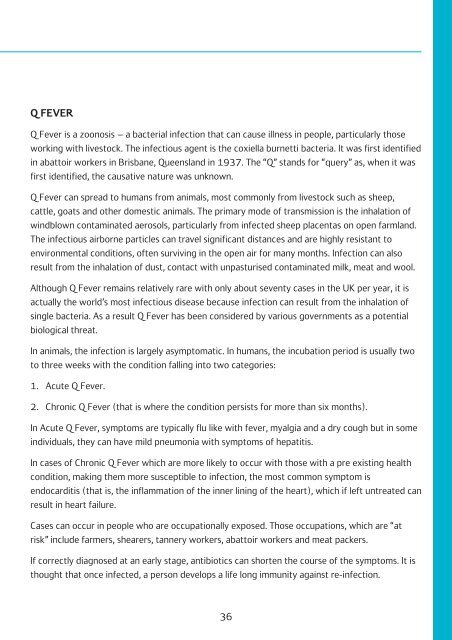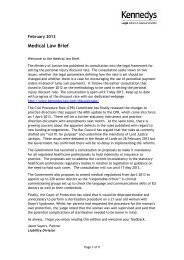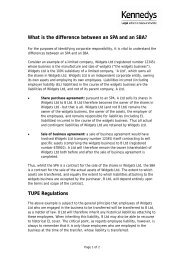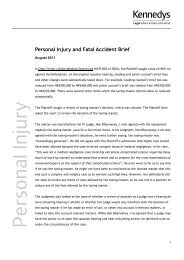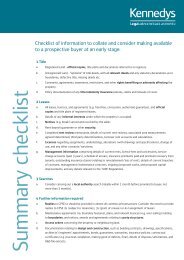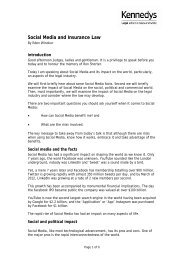Download our Occupational Disease Manual (PDF ... - Kennedys
Download our Occupational Disease Manual (PDF ... - Kennedys
Download our Occupational Disease Manual (PDF ... - Kennedys
You also want an ePaper? Increase the reach of your titles
YUMPU automatically turns print PDFs into web optimized ePapers that Google loves.
Q FEVER<br />
Q Fever is a zoonosis – a bacterial infection that can cause illness in people, particularly those<br />
working with livestock. The infectious agent is the coxiella burnetti bacteria. It was first identified<br />
in abattoir workers in Brisbane, Queensland in 1937. The “Q” stands for “query” as, when it was<br />
first identified, the causative nature was unknown.<br />
Q Fever can spread to humans from animals, most commonly from livestock such as sheep,<br />
cattle, goats and other domestic animals. The primary mode of transmission is the inhalation of<br />
windblown contaminated aerosols, particularly from infected sheep placentas on open farmland.<br />
The infectious airborne particles can travel significant distances and are highly resistant to<br />
environmental conditions, often surviving in the open air for many months. Infection can also<br />
result from the inhalation of dust, contact with unpasturised contaminated milk, meat and wool.<br />
Although Q Fever remains relatively rare with only about seventy cases in the UK per year, it is<br />
actually the world’s most infectious disease because infection can result from the inhalation of<br />
single bacteria. As a result Q Fever has been considered by various governments as a potential<br />
biological threat.<br />
In animals, the infection is largely asymptomatic. In humans, the incubation period is usually two<br />
to three weeks with the condition falling into two categories:<br />
1. Acute Q Fever.<br />
2. Chronic Q Fever (that is where the condition persists for more than six months).<br />
In Acute Q Fever, symptoms are typically flu like with fever, myalgia and a dry cough but in some<br />
individuals, they can have mild pneumonia with symptoms of hepatitis.<br />
In cases of Chronic Q Fever which are more likely to occur with those with a pre existing health<br />
condition, making them more susceptible to infection, the most common symptom is<br />
endocarditis (that is, the inflammation of the inner lining of the heart), which if left untreated can<br />
result in heart failure.<br />
Cases can occur in people who are occupationally exposed. Those occupations, which are “at<br />
risk” include farmers, shearers, tannery workers, abattoir workers and meat packers.<br />
If correctly diagnosed at an early stage, antibiotics can shorten the c<strong>our</strong>se of the symptoms. It is<br />
thought that once infected, a person develops a life long immunity against re-infection.<br />
36


